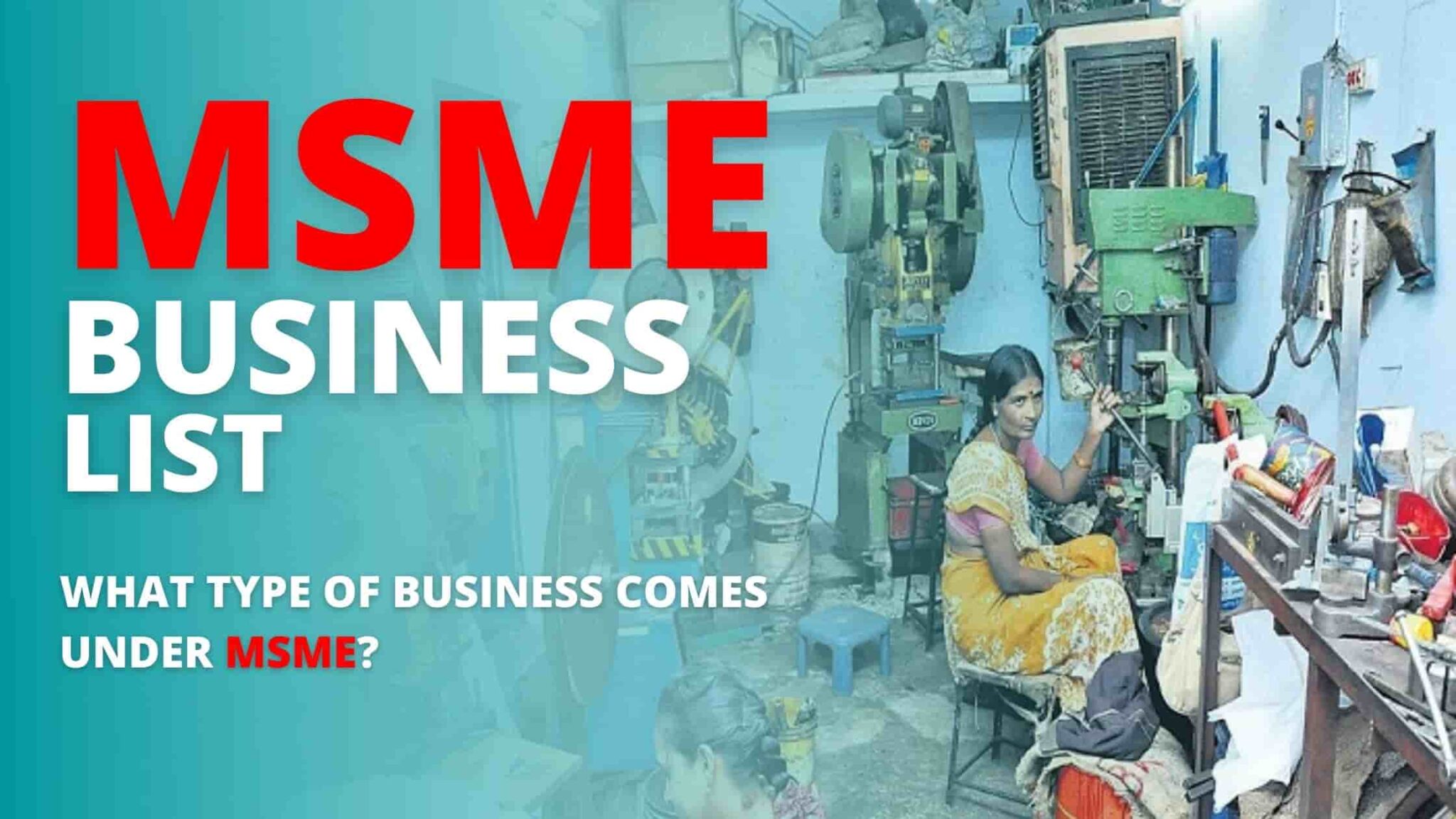Here we have discussed on the msme business list, which is the list of micro small and medium enterprises. And some of the profitable business under the MSME. And the reason for SME growth.
What kind of businesses fall under the MSME?
Take a look at the complete list of MSME companies.
Micro, Small, and Medium Enterprises (MSME) is an acronym for Micro, Small, and Medium Enterprises. MSME employs around 45 percent of India’s entire domestic industrial workforce, making it the economic backbone of the country. In a country, there are many different types of companies, such as service businesses, manufacturing businesses, and trade businesses. The government, on the other hand, has not contemplated including all firms in the MSME programme.
The Micro, Small, and Medium Enterprises (MSME) sector of the Indian economy has developed as a lively and active industry. MSMEs not only serve an important role in creating large numbers of jobs at a cheaper cost of capital than major businesses, but they also aid in the industrialization of rural and backward regions, decreasing regional imbalances and ensuring a more equal distribution of national revenue and wealth.
MSMEs serve as auxiliary units to big enterprises, and this sector makes a significant contribution to the country’s socioeconomic growth.
In terms of commercial prospects, India offers great potential for investors and entrepreneurs. In terms of SME business, India has always been in the spotlight. Financial services, communications, education, autos, media, food, real estate, and so on are all examples of SME business opportunities in India.
Small and medium-sized companies are extremely important in India’s economy. They are a valuable source of entrepreneurial skills, innovation, and employment possibilities. Small and medium-sized businesses (SMEs) are the most essential contributors to every country’s economy, and the same is true in India. In truth, SME is one of the most significant sectors of the Indian economy in terms of employment creation.
Because over 65 percent of India’s population lives in rural and semi-rural areas, small businesses have become a major source of income for many individuals. After agriculture, small businesses employ the second-largest number of people in India.
India’s SME business sector is vast and brimming with fresh prospects. India’s commercial environment is driven by increased purchasing power and consumption. As a result, there is a competitive advantage potential that may greatly benefit investors and businesses. Any excellent small business opportunity offers rich returns and success in a shorter period of time.
So, aren’t you interested in learning more about MSME businesses? If that’s the case, consider yourself lucky since we’ve covered all you need to know in this post, including the most current changes.
A comprehensive list of MSME enterprises may be found here.
MSME Business List
- Leather products.
- Moulding – This includes products like combs, umbrella frames, plastic toys, etc
- Natural Fragrance and Flavours.
- Placement and Management Consultancy Services.
- Training and Educational Institute.
- Energy Efficient Pumps.
- Xeroxing.
- Beauty Parlour and crèches.
- Auto repair services, and garages.
- X-Ray Clinics.
- Tailoring.
- Equipment Rental & Leasing.
- Photographic lab.
- Servicing of Agricultural Farm Equipment. This includes tractor, pump repairing, ring boring machine.
- Back Office Operation Relating to Computerised Data.
- STD/ISD booths.
- Retail Trade with low Capital.
- Multi Channels Dish cable T.V. with Dish Antenna.
- Laundry and Dry Cleaning.
- Toughened Metallic Ware.
- Automotive Electronic Component products.
- Electronic Surveillance and Security.
- Mechanical Engineering Excluding Transport Equipment. This is inclusive of steel almirahs, cocks, and valves, wire cutters, etc.
- Engineering and Fabrication.
- Recorders, VCRs, Radios, Transformer, Motors, Watches.
- Micronutrients For Plants.
- Active Pharmaceutical Ingredients and Ayurvedic Products.
- Khadi Products and Hosiery Products.
- Handicraft activities like Spinning, Weaving, Artisans.
- Printing and other products made of paper.
- Coir Industry.
- Furniture and wood products.
- Poultry Farm.
- Bicycle parts.
- Stationery Items.
- Call centre.
- Rubber Products.
- IT Solution Provider. Services include creating a server bank, application service provider, smart card customization, service provider, etc.
- Testing Labs for industries.
- Auto Parts Components. Which includes horn buttons, door channels, wiper blade components, battery cell tester.
- Ceramics and glass products include roofing tiles, glass flooring tiles, granite, etc.
- Retail and wholesale business
Shri Nitin Gadkari, Minister of MSME and Road Transport and Highways, released updated rules for MSMEs in order to develop the MSME sector. Retail and wholesale trader businesses have been added to the MSME sector.
If you want to start a business and looking for Government financial help then udyam registration is must. Click the above link and get your business registered under the Ministry of MSME.
Retail and wholesale trader businesses will now be able to register on the Udyam Registration Portal thanks to the rules. Also, as per RBI recommendations on MSME loans and lending regulations, take advantage of Priority Sectors financing.
This is the most recent list of MSME firms covered by the MSME Act.
You will now require a NIC code in order to register under MSME.
What is a NIC code, exactly? Check this here about NIC code.
Why are some businesses not included in the MSME list?
Organizations that do not engage with manufacturing and offer services will not be classified as MSME, according to the government’s June 2017 notice. This is because the primary goal of MSME is to provide advantages and subsidies to new businesses.
Trading businesses, on the other hand, serve as a conduit between a manufacturer and a client. As a result, it is exempt from this programme. However, a trader who develops items that are unique in some manner and sells them can register.
A trader who sells a product but also provides additional services for the same product can also apply for MSME registration.
For instance, if the dealer sells a certain brand of television and also provides maintenance services for it. As a service provider, he might register under MSME business.
Do you still have concerns or questions about MSME, the firms that fall under it, the papers necessary for MSME registration, or the process for obtaining an MSME certificate?
Udyam registration private consulting has business professionals who can assist you right now. Entrepreneurs and MSMEs may obtain professional help through the Udyam platform, which brings together business experts from diverse niches.
All you have to do now is schedule an appointment with Udyam Experts and start putting your entrepreneurial ambitions and visions into action.
The Reasons for SME Business Growth
The small-scale company sector in India has experienced a surge in growth for a variety of reasons. The following are some of these elements:
• Significant contribution to domestic output
• Low financial requirements
• Significant revenue from exports
• Capacity to develop indigenous technology that is relevant
• Operational adaptability
• Contribution to defence manufacturing
• Industries that are focused on technology
• Substitution of imports
• Mobility in terms of location
• Imports with a low degree of intensity
• Market competitiveness in the United States
• Ability to compete in export markets
The MSME sector has developed into a dynamic and effervescent component of the Indian economy during the last five decades. MSME serves a dual function by providing jobs and industrialising rural/backward areas, therefore reducing regional disparities and guaranteeing a more equitable distribution of national revenue.
MSME’s are merging as auxiliary units with larger companies, contributing to socioeconomic progress. It has 36 million units, employs over 80 million people, and contributes 8% of the country’s GDP.
MSME Sector’s Leading Industries:
- Retail commerce (excluding motor vehicles and motorcycles) and personal and home goods repairs accounted for 39.85% of the total.
- Wearing clothing manufacturing accounts for 8.75 percent of total manufacturing.
- Food and beverage producers account for 6.94 percent of the total.
- 6.2 percent for other services and 3.77 percent for other business activities
- 3.64 percent for hotels and restaurants
- 3.57 percent of sales are for the repair of motor vehicles and bikes.
- Furniture manufacturing is down 3.21 percent, while textiles are down 2.33 percent.
- Fabricated metals, excluding machinery and equipment, account for 2.33 percent, while other metals account for 19.4 percent. Three sub-sectors present a positive picture: Food processing has a lot of promise because of the agro-industrial linkage, textiles has a lot of potential because of innovation, and electronics has a lot of potential because of the ITES linkage.
SMEs employ around 40% of India’s population, or approximately 80 million people, who are provided with a means of livelihood and employment through low-skilled occupations. 1.3 million SMEs account for 45 percent of India’s industrial output and 40% of the country’s overall exports.
They are, in some ways, the backbone of the Indian economy. India has the second-largest number of SMEs in the world, with 48 million, just ahead of China, which has approximately 50 million.
Around 6000 goods are manufactured by 31.7 percent of SMEs, while the remaining 68.2 percent provide a variety of services. If given the proper backing, this sector has the ability to spread industrial expansion across the country.
Micro, Small, and Medium Enterprises (MSME) are the backbone of economic growth in both industrialised and developing nations across the world.
MSME, aptly dubbed “India’s engine of growth,” has played an important role in the country’s development in terms of creating jobs—MSME employs more than 50 million people—scaling manufacturing capabilities, reducing regional disparities, balancing wealth distribution, and contributing to GDP—the MSME sector accounts for 8% of GDP.
The advantage of this industry is that it requires less investment, resulting in large-scale job creation and a reduction in unemployment and underemployment.
Furthermore, this industry has weathered virtually all of the dangers that have emerged from the still-completed local and foreign markets.
In India, the percentage of MSME in the manufacturing, export, and employment sectors is as follows:
Share of each sector in percentages (%)
1) Manufacturing – 45%
2) Exports – 40%
3) Employment – 69%
The contribution of MSME to other industries has been enormous. Despite the fact that the agriculture sector contributes less to GDP than MSME, it is the second largest employment. While it provides approximately 45 percent to the manufacturing sector and maybe 40 percent to exports, it accounts for the majority of employment in India, accounting for around 69 percent.
In India, there are 45 profitable MSME business ideas.
Micro, Small, and Medium Enterprises (MSME) are the backbone of an economy, allowing it to sustain a healthy growth rate and create jobs. In many industrialised and emerging nations, this sector has been seen as a driving force for economic growth and social progress.
MSMEs have made a tremendous contribution to the Indian economy in terms of creating jobs, reducing regional inequalities, encouraging equitable economic growth, and increasing the country’s export potential.
Despite certain infrastructure flaws and obstacles such as a lack of institutional financing and market connections, this industry has had exceptional success in terms of growth.
List of the Most Successful Small Business Ideas in India
- Gold and Diamond Jewellery
- Ladies Undergarment
- Cold Storage (Shrimp & Agricultural Products)
- Skill Development Centre
- A4 and A3 Size Paper
- Acetaldoxime or Acetaldehyde Oxime
- Production of Jute Gunny Bags
- Graphite Crucible
- Hand Sanitizer
- Surgical & N95 Masks
- Gunny (Jute) Bags from Fabric
- Porcelain Insulators
- Baby & Adult Diaper and Sanitary Pads
- Disposable Face Masks
- Particle Board from Wheat/Rice Straw
- Groundnut Oil Production and Refining
- Methanol from Bio-Waste
- Methanol from Coal
- Disposable Nitrile Gloves
- Hydrated Lime Production from Limestone
- Aluminium Foil (Food Packaging and Pharmaceuticals Foils)
- Indian Kitchen Spices (Masala Powder) Spices Powder and Blended Spices, Readymade Mixes (Red Chilli Powder, Sambhar Masala, Biryani Masala, Chicken Fry Masala, and Garam Masala)
- Herbal/Ayurvedic Hand Sanitizer
- Calcium & Zinc Stabilizer for Pipe and Foam Board Application
- Biodegradable Plastic Bags from Corn & Cassava Starch Granules
- Peanut Butter
- Refrigerant Gas R22 Bottling Plant
- Cellophane Film
- E-Waste Recycling Plant
- Aluminium Foil Containers
- Kraft Paper
- Workshop for Motors of Low Voltage (Up-To 1000V) and Distribution Transformers (Maintenance, Overhauls and Repairs.)
- Holiday Resort (Three Star Grade)
- Disposable Surgical Masks
- Rice Milling Unit
- Aluminium Anodizing Unit
- Methyl Ethyl Ketone
- Downhole Seals used for Oil and Gas Industry from Synthetic Rubber
- Aluminium Ingots from Aluminium Scrap
- Disposable Nitrile Gloves (Powder Free)
- Red Oxide Primer
- Discontinuous Sandwich Panel
- Surgical & N95 Masks
- Sodium Borohydride UsingTrimethyl Borate
- Active Pharma Ingredients (API)
- Spice Powder (Turmeric, Chilli, Pepper, Coriander and Cumin Powder)
Learn more about –
Why Udyam Registration Is Required in India
MSME Samadhaan Portal, Process, Documents, Delayed Payment
Benefits of Udyam Registration
New MSME Classification – Micro Small Medium Enterprises
Online Udyam Registration Portal
Benefits of new Income Tax e-filing Portal in Hindi – नई आयकर इ-फ़ाईलिंग पोर्टल के फायदे ।
Difference between old and new Income Tax e-filing Portal in Hindi
New Income Tax e-filing Portal नई आयकर इ-फ़ाईलिंग पोर्टल हिन्दी में ।
Is Udyam Registration Mandatory?
Udyam Registration Benefits in Hindi -उद्यम रेजिस्ट्रैशन सर्टिफिकेट के फायदे
Udyam registration certificate kya hai – उद्यम रजिस्ट्रेशन सर्टिफिकेट क्या है
Udyam Registration NIC Code List – MSME NIC Code List
Get your Udyam Registration Now
Hoping you have learn about the msme business list, what type of business comes under msme, reasons for SME business growth & profitable msme business ideas in India.
Let us know if you are facing any issues while the udyam registration. Do contact us.




